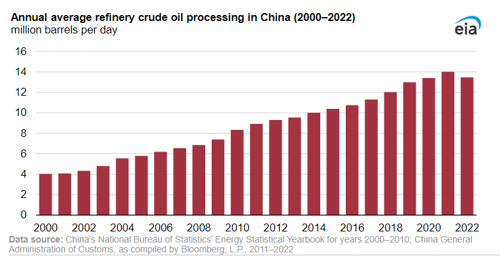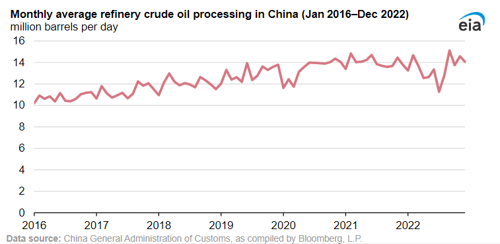Chinese refining utilization dropped in 2022: The first time since 2000
In 2022, refiners in China processed less crude oil than they did in 2021, which was the first year-over-year decrease in processing according to data going back to 2000. Reduced refinery activity in China resulted from numerous factors, including mobility restrictions related to the COVID-19 pandemic and low petroleum product export quotas.

According to China’s General Administration of Customs, refiners in China processed an average of 13.5 MMbpd of crude oil last year, a 4% decrease from 2021's record high of 14 MMbpd. The 2022 reduction in crude oil processing was greatest from April through August, when refiners in China processed an average of only 12.5 MMbpd.
In 2022, refiners in China processed more crude oil early in the year and late in the year. In July, refiners processed the least crude oil (11.3 MMbpd) since January 2018. Refining in China reached its monthly record high of 15.1 million b/d in September 2022 before declining slightly and then rising to more than 14 MMbpd in November and December.
Less domestic demand for crude oil reduced refining activities in China last year. Demand for petroleum products in China declined in response to COVID-19 outbreaks and related mobility restrictions in major cities, including Shanghai. These restrictions significantly slowed China’s economic activity.

Lower petroleum product export quotas also reduced refining activities in China last year. China sets several fuel export quotas every year, allocating a fixed amount of exports to a few, mostly state-owned, refiners. China began issuing lower export quotas around the second half of 2021, and the low export quotas continued through most of 2022. The quotas kept China’s petroleum product exports below 1.5 MMbpd between July 2021 and August 2022, subduing refinery demand.
Crude oil processing hit a record high in September, most likely because refiners expected China to issue a new petroleum product export quotas to promote economic growth, which it did on September 30. China’s petroleum product exports also increased sharply in September, possibly because the expectation of new quotas prompted refiners to use up their existing export quota allocations. Once the new export quotas were in place, refinery activity rose significantly during the fourth quarter. The increase in China’s refinery activity at the end of the year was partially due to increased exports, which averaged 1.7 MMbpd from September through December, up an average 600,000 bpd from the first eight months of the year.






Comments